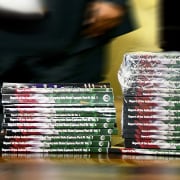|
Getting your Trinity Audio player ready...
|
In our new two-part mini series, we consider the devastating effect of the relentless theft of copper on South Africa’s infrastructure, and the consequent burden such theft places on the country’s economy and society – important topics to consider in this election year. Part one sets the scene as it stands currently, and part two details the ways in which the situation is being addressed, including legislation, law enforcement efforts, and international co-operation.
South Africa is by no means the only country struggling with a copper theft problem. Back in 2017 the Global Railway Review reported that: “The problem has plagued transport networks for years, affecting some of the world’s strongest economies and emerging markets alike.” In Australia, the scale of copper theft has almost tripled in the last three years, in Queensland alone.
On the London Metal Exchange, the price of copper can clearly be seen to be increasing steadily, indicating the strong demand for the metal. This is good news for both legitimate copper mining enterprises and criminals who make their living from copper theft – but bad news for the societies who must bear the burden of theft.
The cost of replacing or resourcing the stolen copper goods can amount to several times more than the actual value of the goods.
A new research report titled South Africa’s Illicit Copper Economy, released in December 2023 by the Global Initiative Against Transnational Organized Crime (GI-TOC), identifies several factors which contribute to the rising theft of copper resources:
- Availability of large areas of unprotected copper.
- Corruption.
- Weakness in criminal justice responses.
- Weak enforcement of regulations and legislation.
- Supply chain where legal and illegal activities are blurred.
- High demand and prices.
- Organised criminal networks.
The international response to copper theft, according to the Illicit Copper Economy report, has been varied in both scope and effectiveness.
“Some of the measures taken by various countries to combat copper theft include the introduction of legislation to regulate scrap metal dealers, the prohibition of cash payments for scrap copper, bans on the export of scrap metal, the introduction of forensic markings on copper cabling, and the use of various technological solutions and innovations to detect and prevent theft.”
Domestic legislation pertaining to copper theft
South Africa’s legislation pertaining to this situation consists of three main pieces –
- The Second-Hand Goods Act (Act 6 of 2009) (SHGA) regulates all second-hand goods dealers, including scrap metal dealers, with the aim of combating the trade in stolen goods and promoting ethical standards.
- The Criminal Matters Amendment Act (Act 18 of 2015) (CMAA) provides for stricter measures on bail and sentencing for essential infrastructure-related offences. This act also creates an offence that criminalises damage to essential infrastructure caused by tampering with or disrupting the functioning of basic services through criminal activity.
- The Prevention of Organized Crime Act (Act 121 of 1998) (POCA) provides measures to combat organised crime, money laundering, racketeering and criminal gang activity, and provides for the recovery of the proceeds of unlawful activity and the civil forfeiture of criminal assets used to commit an offence or assets that are the proceeds of unlawful activity.
The Second-Hand Goods Act
The SHGA regulates all second-hand dealers, including scrap metal dealers and recyclers – they must be registered and accredited with the South African Police Service (SAPS). The act also regulates potentially suspicious transactions, including the possession, acquisition, and disposal of controlled non-ferrous metals, and dealers are obliged to report any suspicious transnational activity to the police.
The SHGA introduced a dual oversight system – government regulation and self-regulation – and made provision for the accreditation of industry bodies which set industry standards and monitor compliance through inspections.
The SGHA was passed in 2009, but only fully enacted in 2012, ostensibly to allow the police time to put systems and procedures in place to implement it. However, 10 years later, the SAPS 2020/21 annual report reveals the following concerning information:
“In an effort to enhance the administration of the Second-Hand Goods Act, 2009 (Act No 6 of 2009), it is anticipated that the Second-Hand Goods Control System will be operational, before the end of the 2020/2021 financial year, after which full implementation of the system will commence.”
This means that more than 10 years after the act was passed, system controls are still not in place.
The Criminal Matters Amendment Act
The CMAA came into effect in 2016, and its influence, says the report, is “increasingly being seen not only in prosecutions but also by judges in sentencing, with longer terms being given to offenders found guilty”.
However, these cases have mostly been limited to level one and two actors – classified in the report as criminals who steal copper, and informal and small-scale scrap metal dealers, respectively. This means that the bigger actors, such as recyclers, mills, and exporters of stolen copper (level three) and international buyers (level four) are allowed to continue their operations unhindered.
The Prevention of Organized Crime Act
The POCA came into effect in 1999. It allows police and prosecutors to charge people for taking part in organised criminal activity. However, it has not been as effective as first envisioned – for one, its use is, according to the report, “seen as requiring too many resources and too much effort”.
But in cases where the POCA has been used to prosecute syndicates involved in copper theft, the report notes, the state has been able to charge the criminal actors involved with theft, receiving stolen goods, money laundering, running a criminal enterprise, and racketeering, all of which carry hefty sentences.
As recently as April 2023, five members of a syndicate were handed substantial prison sentences, ranging from 77 years to 18 years, for convictions for cable theft, receiving stolen property, racketeering, and money laundering.
Policing stolen copper
Under the SHGA, police stations are required to have designated police officers (DPOs) who must do compliance inspections. However, often DPOs are not trained well enough to be aware of all the details of the legislation or how to accurately register offences. These officers are also responsible for compliance inspections of firearm and liquor dealers, which creates an additional challenge.
There are still far more reported incidents of theft than there are prosecutions and convictions for those offences. “Transnet, Prasa and Eskom identified almost 11 000 incidents per year from 2018 to 2022, and if municipalities were included the total would be even higher. However, from March 2019 to March 2022, only 1 200 copper cable thieves were arrested, resulting in 580 court cases.”
Convictions for the same period amounted to 40, the Illicit Copper Economy report adds.
“At the local station level, police lack the understanding of the issue, different prescripts, and legislation.”
In addition, the SAPS does not categorise copper theft as such, but rather under the vague category of ‘thefts not mentioned elsewhere’. This complicates the production of accurate statistics on the theft of copper.
The police also managed fewer successful seizures in the 2021/22 financial year compared to the previous year, when they seized more than 72 tonnes of illicit copper, of which more than 52 tonnes was copper cabling. The following year this amount fell by almost half to 38.4 tonnes, of which around 26.4 tonnes was cabling. “Notably, this decline occurred in the context of an increase in copper theft.”
The report does note some encouraging signs over the last three years in terms of convictions and sentences for copper theft – but as with the above-mentioned scenario, these are confined mainly to level one and two actors.
Furthermore, says the report, according to a senior investigator in the Directorate for Priority Crime Investigation, “not much is being done to infiltrate the copper syndicates’ inner circles”.
Policing South Africa’s ports
The country’s ports, which are generally poorly policed, are a significant exit point for stolen and smuggled copper because of lax vigilance. The metal is largely detected via random container searches rather than intelligence-led operations. A security expert interviewed by the author of the Illicit Copper Economy report said: “Your chances of being detected at the port was about 1%. The risks of smuggling illicit copper are low and the rewards extremely high.”
The cost implications of targeted searches are also very high, and with Transnet – the custodian of South Africa’s ports – in financial and operation disarray, the exercise becomes onerous.
“You can get 24 tonnes of copper into a shipping container, so it is a great find, but there is a big cost implication to searching, even if your information is good,” said another expert. “It is almost impossible to search containers at the port because once you’ve identified the suspect box you need a specialist crane to extricate it from the stack. Once you have done that, you have to unpack the container manually. It takes a day to unpack one container. It is a mission.”
New measures on the cards
The Department of Trade, Industry and Competition is implementing new measures to address the damage caused to public infrastructure by metal theft. The measures were approved by Cabinet in November 2022 and followed the receipt of more than 2 800 comments on a new draft scrap metal policy which was put out for public comment in August 2022.
The new policy is being implemented in phases. “The first phases, some of which have already been implemented, include a six-month ban on the export of scrap metal; the introduction of a permit system for the export of semi-finished ferrous and non-ferrous metal products; the introduction of a permit system for the import of furnaces and other machinery capable of transforming metal and disguising the origin of scrap metal; and the establishment of an interdepartmental metal trade task force.”
The metal trade unit will work with SAPS economic infrastructure task teams to monitor and coordinate efforts to combat theft and damage to infrastructure as a result of incentives from the scrap metal trade.
When phase two is implemented, it will involve the introduction of a permit system for scrap exports – this will come into effect after the export ban ends. The ban has been extended several times and there is a proposal for another six-month extension, meaning that the ban will run into mid-2024 – despite the department’s acknowledgement that the ban has had limited success in curbing copper theft.
Another expert said that the ban had merely forced illegal scrap merchants to become more adept at avoiding tariffs and disguising their stolen products.
The new measures will also include amendments to the SHGA regulations, the introduction of additional reporting requirements to track the trade in scrap metal, restrictions on the ports and land borders to be used by exporters, and strengthened regional and continental policy co-ordination.
The third phase will involve possible legislative changes and the potential introduction of a new dedicated metal trading statute.
Download and read the report for details of the implications of these new legislative changes.
International co-operation
Effective action against transnational crime, which encompasses the illicit scrap copper trade, requires transnational co-operation between law enforcement, customs, and other relevant bodies, and between South Africa and international destination markets.
“The new policy measures mention that the South African government will pursue policy co-ordination with various regional bodies, including the Southern African Development Community, the Southern African Customs Union, and the African Union.”
The SAPS already has various mutual co-operation agreements with international partner agencies, and as one particular example that could boost action against the illicit copper trade, the report cites the particular example of the co-operation agreement between South Africa and China, signed in 2000.
“This agreement has been applied to the illegal wildlife trade, where the two countries have worked together to target transnational criminal networks involving actors from both countries. South African and Chinese police have shared information and intelligence and conducted joint operations, including allowing so-called controlled deliveries to take place and then arresting the recipient of the smuggled wildlife products.”
Recommendations
The Illicit Copper Economy suggests that unless serious action is taken to address the networks involved, the outlook for South Africa is not good, and the problem is likely to grow.
“Networks and criminal actors involved in copper theft have become more sophisticated and have shown that they are able to adapt their operations at a speed that is often significantly faster than the state.”
- Because of the transnational nature of the copper supply chain and the networks involved, intergovernmental co-operation between various criminal justice agencies, the South African Revenue Service, and other relevant bodies is required, as well as the commitment and co-operation of governments and law enforcement agencies in the countries receiving the stolen copper.
- More emphasis needs to be placed on strategic investigations and prosecutions, says the report. These actions must target the high-level actors who are integral to the copper theft market, rather than focusing solely on the level ones and twos.
- Crime intelligence has an important role to play in identifying these major actors and how they operate. Priority must also be given to targeted investigations of copper thieves who are also major players in other illicit markets and criminal enterprises.
- Furthermore, says the report, both the CMAA and the POCA need to be used more extensively and effectively in the investigation and prosecution of people involved in copper theft.
- The SAPS and local municipalities must make a concerted effort to close down informal scrap metal traders and bucket shops. The SAPS must establish a central electronic database of registered dealers and make this available to its members and municipal law enforcement agencies, who must work together to shut down the operations trading outside of the database.
- A relatively quick and easy win, says the report, would be to address the mislabelling of scrap copper as raw copper.
- The SAPS’ current lackadaisical system of reporting copper theft under the catch-all category of ‘theft not reported elsewhere’ must be addressed, including a review of how copper and scrap metal theft are recorded. A separate reporting line must be developed for these cases.
- Any raid in which copper is seized and arrests made should trigger an automatic investigation, under section 10.3 (a) of the SHGA – this section allows the national police commissioner to revoke the registration of dealers who fail to comply with the conditions of registration or the SGHA. Dedicated investigators with the necessary skills and expertise should be assigned to carry out such checks and to record and report the findings to Parliament. These details should also be included in the SAPS annual report tabled in Parliament.
- The functioning of the Non-Ferrous Metals Crime Combating Committee must be improved and supported by more active participation from both detectives and the National Prosecuting Authority.
- It would be useful, the report concludes, if the government reported regularly to communities – who are significantly impacted by copper theft – and the public on progress made and challenges faced. This would also help to build public confidence.








